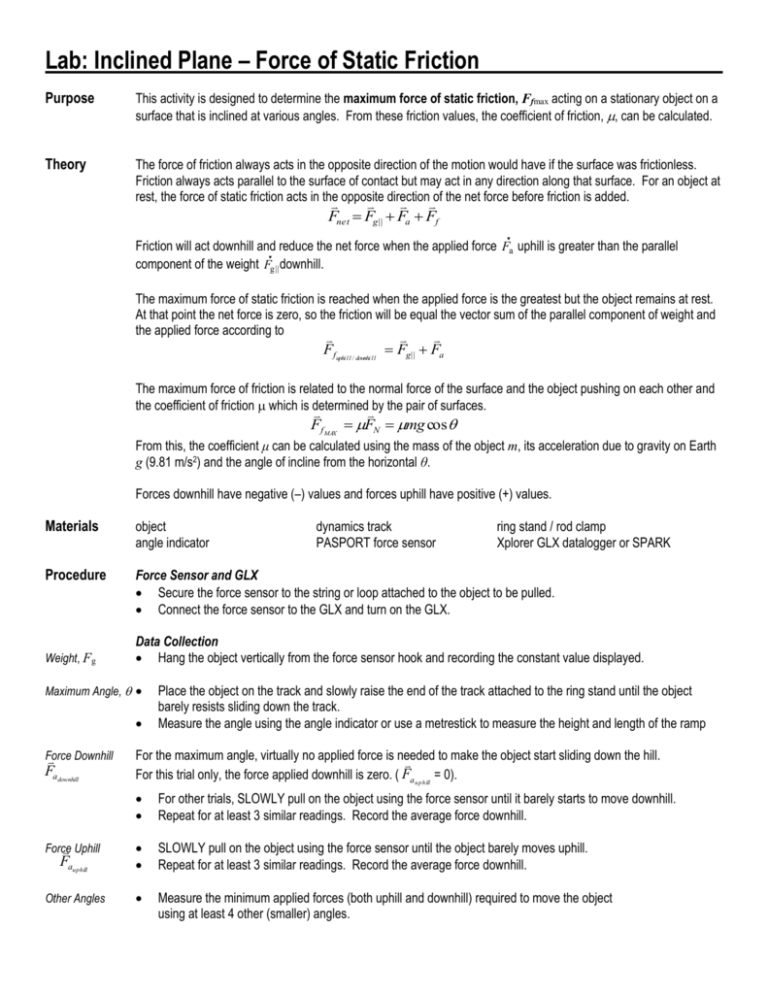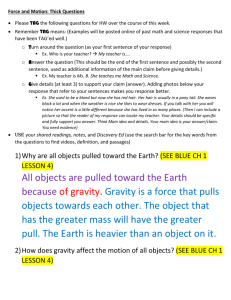Lab: Inlcined Plane * Force of Static Friction
advertisement

Lab: Inclined Plane – Force of Static Friction Purpose This activity is designed to determine the maximum force of static friction, Ffmax acting on a stationary object on a surface that is inclined at various angles. From these friction values, the coefficient of friction, , can be calculated. Theory The force of friction always acts in the opposite direction of the motion would have if the surface was frictionless. Friction always acts parallel to the surface of contact but may act in any direction along that surface. For an object at rest, the force of static friction acts in the opposite direction of the net force before friction is added. Fnet Fg|| Fa Ff v Friction will act downhill and reduce the net force when the applied force Fa uphill is greater than the parallel v component of the weight Fg|| downhill. The maximum force of static friction is reached when the applied force is the greatest but the object remains at rest. At that point thenet force is zero, so the friction will be equal the vector sum of the parallel component of weight and the applied force according to Ffuphi l l / downhi l l Fg|| Fa The maximum force of friction is related to the normal force of the surface and the object pushing on each other and the coefficient of friction which is determined by the pair of surfaces. Ff MAX FN mg cos From this, the coefficient μ can be calculated using the mass of the object m, its acceleration due to gravity on Earth g (9.81 m/s2) and the angle of incline from the horizontal θ. Forces downhill have negative (–) values and forces uphill have positive (+) values. Materials object angle indicator Procedure Force Sensor and GLX Secure the force sensor to the string or loop attached to the object to be pulled. Connect the force sensor to the GLX and turn on the GLX. Weight, Fg ring stand / rod clamp Xplorer GLX datalogger or SPARK Data Collection Hang the object vertically from the force sensor hook and recording the constant value displayed. Maximum Angle, Force Downhill Fadownhill dynamics track PASPORT force sensor Place the object on the track and slowly raise the end of the track attached to the ring stand until the object barely resists sliding down the track. Measure the angle using the angle indicator or use a metrestick to measure the height and length of the ramp For the maximum angle, virtually no applied force is needed to make the object start sliding down the hill. For this trial only, the force applied downhill is zero. ( Fa u p h ill = 0). For other trials, SLOWLY pull on the object using the force sensor until it barely starts to move downhill. Repeat for at least 3 similar readings. Record the average force downhill. Force Uphill Fauphill SLOWLY pull on the object using the force sensor until the object barely moves uphill. Repeat for at least 3 similar readings. Record the average force downhill. Other Angles Measure the minimum applied forces (both uphill and downhill) required to move the object using at least 4 other (smaller) angles. Raw Data Brief description of the object: Weight of the object Fg = _______________ Table 1. Applied forces downhill and uphill for various inclines and the corresponding parallel component of weight and forces of static friction. Angle, Weight Downhill, Fg || Applied Uphill Fau p calculated using Fg and from GLX – – – – – + + + + + Parallel Forces (N) Friction Downhill Ff down – – – – – Applied Downhill Fa down Friction Uphill Ff from GLX – – – – – up + + + + + Table 2. Coefficients of friction for various inclines. Angle, Normal Force, FN Friction Downhill Ff down calculated using Fg and from Table 1 coefficient of friction μ Friction Uphill Ff up coefficient of friction μ from Table 1 The data should be entered in order with the smallest angle first. Use the data in the first data set to show one sample of every type of calculation used. Conclusions In general, how do the applied forces uphill and downhill compare? Is this what you expected? Briefly explain. In general, how do the forces of friction uphill and downhill compare? Is this what you expected? Briefly explain. How do the applied forces change as the angle increases? Is this what you expected? Briefly explain. How do the friction forces change as the angle increases? Is this what you expected? Briefly explain. State the value of the coefficient of friction. Identify and explain when this value was the greatest and when it was the least. What changes would improve this investigation to make it more effective, more accurate, more precise, or more interesting?







